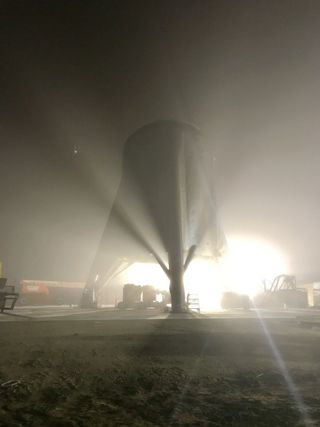
SpaceX's Mars-colonizing tech will take a big leap soon, if all goes according to plan.
The Starhopper spacecraft, a prototype of SpaceX's Starship Mars vehicle, is scheduled to make its first untethered test flight Tuesday (July 16), company founder and CEO Elon Musk said.
"Raptor engine mounted on Starhopper. Aiming for hover test Tues," Musk said via Twitter Saturday (July 13). "~20 m [meters, 66 feet] up & sideways for first flight. Mk1 Starship hopefully 20 km [12 miles] up in a few months," he added in another tweet.
Related: SpaceX's 'Starship' Prototype Coming Together in Florida (Photos)
Starhopper has made two brief test flights to date, both of them while tethered to the ground for safety's sake. Those flights occurred in April at SpaceX's Boca Chica facility, near Brownsville, Texas. The upcoming, untethered flight will also occur at Boca Chica.
This first version of Starhopper features one of SpaceX's advanced, next-generation Raptor engines. SpaceX has been testing the engine that will soon fly extensively over the past few weeks, and it is apparently now ready to go, as Musk said.
Raptor engine mounted on Starhopper. Aiming for hover test Tues.July 12, 2019
A Tuesday test is apparently not in the cards, however. Starhopper fans in South Texas noted that SpaceX has not yet static-fired the Raptor — a standard engine test SpaceX performs before launches and flight tests.
Get the Space.com Newsletter
Breaking space news, the latest updates on rocket launches, skywatching events and more!
No static fire tonight...but another day closer to watching StarHopper's first untethered hop! It was very cool seeing the first batch of professional rocket launch photographers @TrevorMahlmann and @thejackbeyer on South Padre Island getting pics from Isla Blanca Park. pic.twitter.com/6bYTT3jMuAJuly 16, 2019
Future, higher-flying iterations of Starhopper will sport three Raptors. The fully operational, 100-passenger Starship will have six of the engines. Starship will launch atop a huge rocket called Super Heavy, which will be powered by 31 Raptors. Both Starship and Super Heavy will be reusable.
Indeed, SpaceX is counting on both vehicles to fly frequently and repeatedly, bringing the cost of launch down enough to make it economically feasible to tackle Mars settlement and other ambitious exploration feats.
SpaceX is building Starship prototypes at Boca Chica and on Florida's Space Coast, reasoning that some competition will improve the vehicle's design.
The Starship-Super Heavy duo has one confirmed mission on its docket: a round-the-moon trip booked by Japanese billionaire Yusaku Maezawa, who plans to take a group of artists with him. That flight is targeted for 2023. But SpaceX is looking to launch an uncrewed commercial satellite mission sooner — perhaps as early as 2021.
- SpaceX's Starship and Super Heavy Mars Rocket in Pictures
- See the Evolution of SpaceX's Rockets in Pictures
- SpaceX's Raptor Engine Hits Power Level for Starship Launches
Editor's Note: This story was updated on July 16 to state that SpaceX has not yet performed a static-fire test, according to Starhopper watchers.
Mike Wall's book about the search for alien life, "Out There" (Grand Central Publishing, 2018; illustrated by Karl Tate), is out now. Follow him on Twitter @michaeldwall. Follow us on Twitter @Spacedotcom or Facebook.
Join our Space Forums to keep talking space on the latest missions, night sky and more! And if you have a news tip, correction or comment, let us know at: community@space.com.

Michael Wall is a Senior Space Writer with Space.com and joined the team in 2010. He primarily covers exoplanets, spaceflight and military space, but has been known to dabble in the space art beat. His book about the search for alien life, "Out There," was published on Nov. 13, 2018. Before becoming a science writer, Michael worked as a herpetologist and wildlife biologist. He has a Ph.D. in evolutionary biology from the University of Sydney, Australia, a bachelor's degree from the University of Arizona, and a graduate certificate in science writing from the University of California, Santa Cruz. To find out what his latest project is, you can follow Michael on Twitter.
